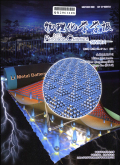物理化学学报2024,Vol.40Issue(5):42-45,4.DOI:10.3866/PKU.WHXB202305043
超薄2D/2D NiPS3/C3N5异质结的界面工程促进光催化产氢
Interfacial Engineering of Ultrathin 2D/2D NiPS3/C3N5 Heterojunctions for Boosting Photocatalytic H2 Evolution
摘要
Abstract
This study focuses on exploring efficient photocatalysts for water splitting,which holds great potential for harnessing hydrogen(H2)as a renewable energy source.Modulating the heterojunction interface is known to enhance charge carrier separation and solar energy utilization,thereby boosting photocatalytic activity.In this work,a mechanical mixing-assisted self-assembly approach was developed to construct a heterojunction between NiPS3(NPS)nanosheets(NSs)and C3N5(CN)NSs.Specifically,two-dimensional(2D)NPS NSs were tightly deposited on 2D CN NSs surface to gain a 2D/2D heterostructure.The photocatalytic performance of the synthesized photocatalysts was determined by their ability to generate H2 through water splitting,both in deionized(DI)water and seawater,under visible light.The resulting NPS NSs/CN NSs(NPS/CN)composites possessed boosted photocatalytic hydrogen evolution(PHE)activity related to CN NSs and NPS NSs.This improvement was assigned to the synergistic effect of increased light-harvesting capacity and heterojunction formation.Nevertheless,an excessive amount of deposited NPS NSs on the surface of CN NSs was found to reduce the light absorption of the CN NSs component in the NPS/CN composites,resulting in decreased PHE activity.Therefore,it was determined that an appropriate mass ratio between the two components is necessary to achieve excellent photocatalytic activity for the NPS/CN composites.The optimized photocatalyst,referred to as 3-NPS/CN,demonstrated the highest visible-light-driven PHE efficiency of 47.71 μmol∙h-1,which was 2385.50 times higher than that of CN NSs.Moreover,3-NPS/CN also exhibited excellent PHE activity in seawater,with a rate of 8.99 μmol∙h-1.The photoelectrochemical,steady-state photoluminescence(PL),time-resolved PL(TR-PL),steady-state surface photovoltage(SPV)and time-resolved surface photovoltage(TPV)techniques were performed to investigate the charge separation and migration behaviors of various photocatalysts.Based on the characterization results,our group proposed a reasonable PHE mechanism.In the NPS/CN photocatalysts,photo-induced electrons rapidly migrated from the conduction band(CB)of CN NSs to the CB of NPS NSs due to the potential difference and strong interfacial electronic coupling between the two materials.The photogenerated electrons accumulated on the CB of the NPS NSs component efficiently reduced protons to generate H2 molecules.Concurrently,photogenerated holes on the valence band(VB)of CN NSs and NPS NSs were consumed with the assistance of triethanolamine(TEOA)molecules.This study presents a facile method for fabricating 2D/2D heterostructured photocatalysts,which hold promise for efficient and robust implementation in energy applications.关键词
C3N5纳米片/NiPS3纳米片/光催化/产氢/异质结Key words
C3N5 nanosheets/NiPS3 nanosheets/Photocatalysis/Hydrogen production/Heterojunction分类
化学引用本文复制引用
胡佳伟,夏楷,杨奥,张志豪,肖雯,刘超,张勤芳..超薄2D/2D NiPS3/C3N5异质结的界面工程促进光催化产氢[J].物理化学学报,2024,40(5):42-45,4.基金项目
This work was supported by the National Natural Science Foundation of China(51902282,12274361),Qinglan Project of Jiangsu of China,Natural Science Foundation of Jiangsu Province,China(BK20211361),College Natural Science Research Project of Jiangsu Province,China(20KJA430004)and Open Project of Jiangsu Provincial Key Laboratory of Eco-Environmental Materials,China. 国家自然科学基金(51902282,12274361),江苏高校青蓝工程,江苏省自然科学基金(BK20211361),江苏省高校自然科学研究项目(20KJA430004)和江苏省生态环境材料重点实验室开放课题资助项目 (51902282,12274361)

